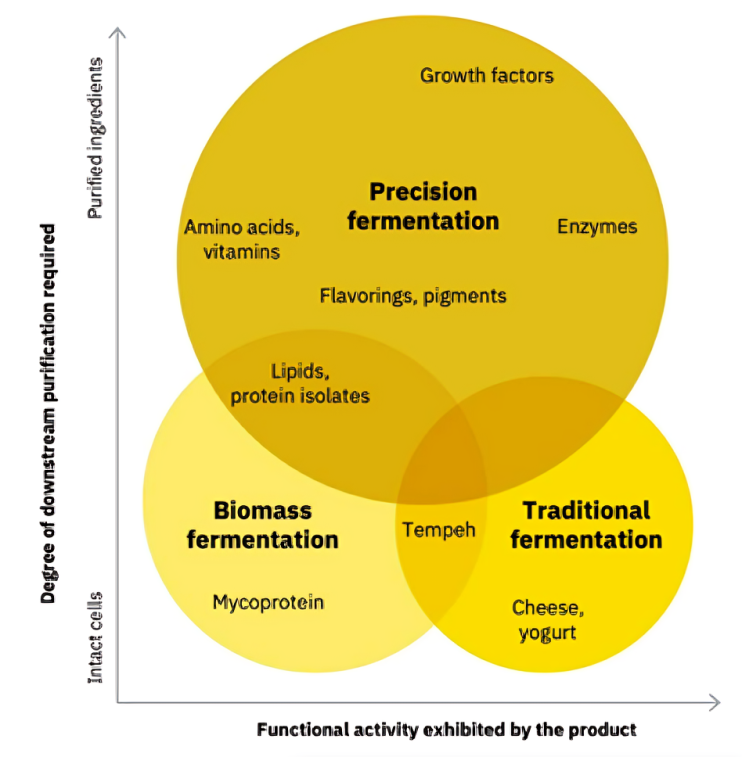What is fermentation?
Do you know what tempeh, cheese, kimchi, and wine have in common? They are all produced through fermentation! This method of food processing dates back to early 6000 BC, where fermentation was largely used as a cost-effective method to preserve food.

So, what is fermentation? Fermentation makes uses of microorganisms like yeast and fungi to break down complex components in food to various by-products, such as alcohol and protein. The change in composition of the food products after fermentation also changes the sensory properties of the food. That is why wine has its characteristic alcoholic taste, instead of tasting like ordinary grape juice!
Fermentation and plant-based foods
In a world where food scarcity and food security are rising issues, alternative proteins are being developed as a more sustainable food source compared to animal meats. Plant-based proteins, mycoprotein, insects, algae and cultured meat are the current major alternative protein sources in the formulation of meat substitutes. With a significant amount of research in this area, these sources, especially plant-based proteins, are advocated as healthier, more ethical, and more sustainable compared to animal meat.
However, a critical issue with plant-based proteins is their inability to wholly mimic the taste and texture of animal meat, largely due to differences in the protein composition and structure. Fermentation may provide a potential solution to transform the components in plant-based protein to improve its taste and texture, as well as boost its nutritional value. The concept of applying fermentation in plant-based products has been practiced for centuries, examples including natto and tempeh production. Furthermore, fermentation is gaining popularity as a method to process novel plant-based protein. According to industry report from the Good Food Institute, there were >130 companies focused on fermentation for alternative proteins in 2022, with an increase of 12% compared to 2021.
3 Types of Fermentation
There are 3 types of fermentation: a) Traditional Fermentation, b) Biomass Fermentation and c) Precision Fermentation. Precision fermentation is currently the most relevant for the PBMA space.
Table 1 Summary of the 3 Methods of Fermentation (Information from The Good Food Institute and Perfect Day)
| Traditional Fermentation | Biomass Fermentation | Precision Fermentation | |
| How is it made? | Use of intact, live microbes for fermentation | Mass produced protein through quick and efficiently growing microbes | Specific microbes are identified and designed to provide the desired end-products efficiently and effectively |
| Benefits | Improves nutritional content, flavour, texture, and shelf-life of products | Can increase digestibility and protein content | Opportunity to create high-end value products |
| Examples | Tempeh, Cheese and Yoghurt | Marmite – first biomass product | Impossible Foods’ heme protein |

Benefits of fermentation for plant-based proteins
How is fermentation beneficial in the context of plant-based proteins? Fermentation has showed potential in improving sensory quality, bioavailability and digestibility of the nutrients and protein compounds in these proteins.
1. Fermented PBMAs: More Nutritious, Better Protein Digestion and Safe!
Fermentation has been shown to increase the levels of bioactive compounds and bioavailability of nutrients (e.g. iron and zinc). Meat analogues made with tempeh or mycoprotein were shown to improve nutrient absorption from the intestine.
Compared to animal meat proteins, plant proteins are harder for the human body to break down due to its bigger and more complex protein structures. But fret not, as studies have found that fermentation increases the digestibility of such plant proteins by breaking down these large, complex plant proteins into smaller protein fractions and free amino acids.
In terms of product stability, organic acids created during fermentation could slow down the growth of food pathogens or spoilage microorganisms, leading to better product stability, lower risk of food poisoning, and a longer shelf-life.
2. Fermented PBMAs: For better taste and texture!
It is important for food to taste good for it to be a successful product. While there is constant advancement in plant-based meat analogue (PBMA) processing technologies, there has not been any success in creating a PBMA product that fully tastes like animal meat. It is challenging to create the fatty, meaty taste and fibrous texture characteristics of animal meat due to the differences in the protein structures.
However, fermentation could possibly be the key to overcome these challenges! A study using microorganism B. subtilis produced a PBMA with improved sensory qualities, such as better chewiness and firmness, compared to the unfermented product. Another study showed that yeast fermentation could mask off-flavours, such as the beany flavour in okara (soybean residue).
3. Fermented PBMAs: Are consumers ready to accept them?
How does the public view fermentation? An online study showed that 2 in 5 US adults are open to purchasing products made via precision fermentation. Moreover, 4 in 5 consumers are keen to purchase these products when they are given more information regarding the fermentation technology. Interestingly, companies have surveyed the ground and found that consumers prefer terms like “whey protein from fermentation” over “whey protein” or “non-animal whey protein”. The majority of consumers are not worried about the safety of these products if the government food agencies have certified them as safe for consumption. As time progresses, consumers are gradually becoming more accepting of technology-driven methods.
Potential of Fermentation in Food Industry
Fermentation can be a promising solution to many of the existing problems plaguing the plant-based meat analogue (PBMA) industry: it improves the nutritiousness and digestibility of plant-based proteins, while reducing its allergenicity. More importantly, it could substantially improve its sensory quality, making it a closer replica to animal meat. Such improvements would make PBMA tastier and appealing to consumers.
As fermented plant-based alternatives are still very novel, there may be some hesitation from consumers to try them. However, with transparency and knowledge provided to consumers, this could help increase acceptability amongst consumers. A group – The Precision Fermentation Alliance is formed to work towards this goal. With active advocacy on its safety, nutritiousness, sustainability, and tastiness, fermentation may become a mainstay in the production of plant-based meat analogues in near future.

